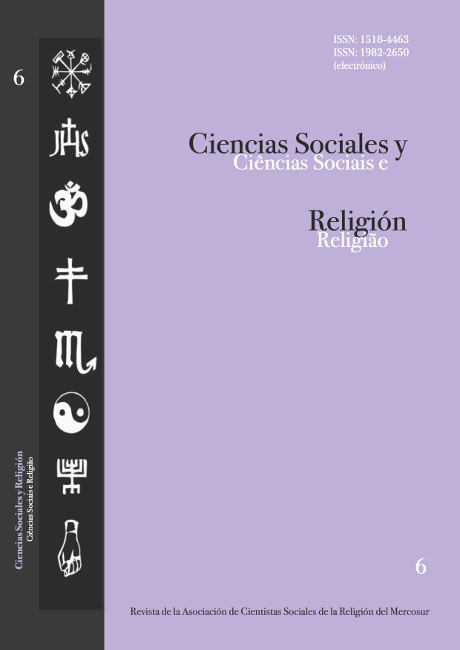Abstract
In this paper I intend to focus on the “creation”, or “recreation”, of new pilgrimage routes within the Brazilian context, and their relation to tourism. I, hereby, analyze five routes, known as “Caminho do Sol (Sunshine Route), Caminho da Luz ( The Light Route), Caminho das Missões (The Missions’ Route), Passos de Anchieta (Anchieta’s Steps) and “Caminho da Fé” (The Faith Route), in the states of São Paulo, Minas Gerais, Rio Grande do Sul, Espírito Santo. All of them are Brazilian “Inventions” based on the model of “Santiago of Compostela Trail” The whole research is based on the assumption that both pilgrimage and tourism can be understood as structures of significance, both pointing to the different possible ways of experiencing such practices and to a diverse range of possible transformations. I understand that the main difference between these two structures of significance (tourism and pilgrimage) lies both on the external character of the sight and on the degree of immersion of the participants of each type of experience.
References
BARREIRO RIVAS, J.L. (1998) La función política de los caminos de peregrinación em la Europa Medieval. Madrid: Tecnos, 1998.
CARNEIRO, Sandra M. C. de Sá (2003) Rumo a Santiago de Compostela: os sentidos de uma moderna peregrinação. Tese de Doutorado em Ciências Humanas (Antropologia Cultural), PPGSA/IFCS/UFRJ, Rio de Janeiro.
CLASTRES, Helène (1978) Terra sem mal: o profetismo tupi guarani. São Paulo: Brasiliense.
COHEN, Erik (1979) A phenomenology of tourist types. Sociology, n. 13, p.179-201.
COLEMAN, Simon e ELSNER, John (1995) Pilgrimage: past and present in the world religions. Cambridge: Harvard University Press, 1995.
COUSINEAU, P (1999) A arte da peregrinação. São Paulo, Ágora.
EADE, John & SALLNOW, Michael (1991) Contesting the sacred. The Anthropology of pilgrimage. London/New York: Routledge.
FERNANDES, Rubem César (1982) Os cavaleiros do Bom Jesus. Uma introdução às religiões populares. São Paulo: Brasiliense.
GRABURN, N (1992) “Turismo: El viaje sagrado”. In: SMITH, Valenel. Anfitriones e invitados: la antropologia del turismo. Madrid: Endymion.
MACCANNELL, Dean (1976) The tourist: A new theory of leisure class. New York: Schocken Books.
SANCHIS, Pierre (1983) Arraial: festa de um povo. As romarias portuguesas. Lisboa: Dom Quixote.
STEIL, Carlos Alberto (1996) O Sertão das romarias. Um estudo antropológico sobre o santuário de Bom Jesus da Lapa - Bahia. Petrópolis: Vozes.
STEIL, Carlos Alberto. (1999) “Peregrinação e turismo: o Natal em Gramado e canela”. In: Teocomunicação, v.29, n.125.
STEIL, Carlos Alberto. (2002) “Peregrinação e turismo religioso: tendências e paradigmas de interpretação”. Newsletter de la Asociación de Asociación de Cientistas Sociales de la Religión en el Mercosur, Buenos Aires, no.13, p.1-5.
STEIL, Carlos Alberto. (2003) Peregrinação, Romaria e Turismo religioso: raízes etimológicas e interpretações sociológicas. In: ABUMANSSUR, Edin Sued (org.) Turismo Religioso: ensaios antropológicos sobre religião e turismo. Campinas: Papirus.
TURNER, Victor (1974) O Processo ritual. Petropólis: Vozes.
TURNER, Victor & TURNER, Edith (1978) Image and pilgrimage in Christian culture. New York: Columbia University Press.
URRY, John (1996) O Olhar do turista: Lazer e viagens nas sociedades contemporâneas. São Paulo: Studio Nobel/Sesc.
VAN GENNEP, Arnold (1978). Os ritos de passagem. Petrópolis: Vozes
VÁZQUEZ DE PARGA, Luis; LACARRA, Jose Maria e URIA RIU, Juan (1993[1948]). Las Peregrinaciones a Santiago de Compostela. Pamplona, Fondo de Publicaciones, Gobierno de Navarra, 3vols.

This work is licensed under a Creative Commons Attribution-NonCommercial-ShareAlike 4.0 International License.
Copyright (c) 2020 Sandra Maria Corrêa de Sá Carneiro
